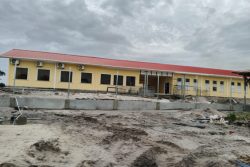Guyana intends to tap into Brazil’s lucrative rice market, if all goes well for a Barbadian company farming in the Rupununi, and take advantage of under-utilized rice mills in the Portuguese-speaking nation while reducing imports of stock feed here.
The Barbadian firm, Simpson Group of Companies, sees its demonstrative farm plots on the Santa Fé mega farm in Region 9, as a huge success and as such is planning not only to expand farming and increase investment but to assist Guyana in becoming the stock feed provider of the Caribbean.
Government also plans to partner with the firm in making futuristic farming goals here a reality. “Because of their success now we see that the 10,000 acres will not be sufficient and they are looking to expand to 30,000 acres …government is also looking favorably at giving them that acreage as it will yield tremendous benefits for us,” Minister of Agriculture Dr Leslie Ramsammy told Stabroek News.
“With the extra land more than US$100 million will be invested… It provides jobs and expands export, thus contributing to reducing imports of corn and soya so that we will reduce totally the importation of those things,” he stated.
He informed that the project which began in 2010 falls under former the Jagdeo Initiative – an agricultural strategic programme aimed at boosting farming throughout Caricom and guaranteeing food security. This would see bartering of agricultural produce in the Caricom Community and would not only enable healthier eating but would reduce international food imports. Further, it is envisaged that the initiative would create more employment, increase export earnings and give farmers new and technologically-advanced ways of farming, among other benefits.
Ramsammy said that to date the value of the investment is US$800,000; and this amount is just on the demonstrative plots. So far, he said, 120 acres have been used to cultivate rice which is expected to be harvested in the first week of June and yield 720 tonnes of rice or six tonnes per acre.
However, in the next phase the investors will pump in US$6 million to US$10 million overall to develop 10,000 acres.
“They checked to see if the crops they are growing are doing so with the same yield and productivity as in other countries. It would be crazy to be producing say 16 tonnes per acre and you have Brazil at 40 per acre because then you know you just can’t compete… The trick is to grow at the yield that will make us competitive,” he added.
According to Ramsammy as this is only the trial phase of rice farming, in addition to it being the first crop, the small amount yielded per tonne is expected. However, he said that as farming continues it is expected to yield as much as 12 tonnes per acre. He also explained that with the variety of rice being used the 12 tonnes per acre is possible.
Questioned about the target market, he said, “Initially because of transport the target market will be Brazil.
“Brazil has the need for rice and the Roraima province has mills which are 60% under-utilised. So the milling will be done there and they also require large amounts of rice for their own usage so we see already a market there.”
Not all of the land allocated to the project will go towards rice as the company already has also tested soya, different varieties of cassava and passion fruit among other crops.
The minister emphasized the promise of growing soya here since he said this crop can serve to decrease significantly if not eliminate Guyana’s dependence on importing stock feed. Another crop being looked at is corn and given the land type it is estimated that this too would be lucrative. “They have succeeded in growing soya… 200 million tonnes are imported into this region for stock feed we are hoping to tap into that market so not only will we decrease imports; we will increase export while at the same time it means that we will see a reduction in the price for stock feed for us,” he said.







